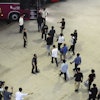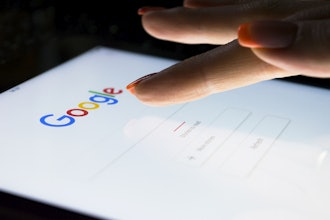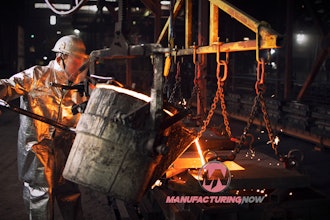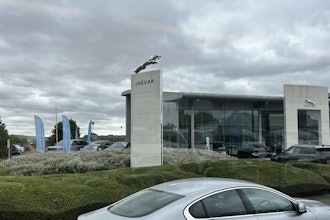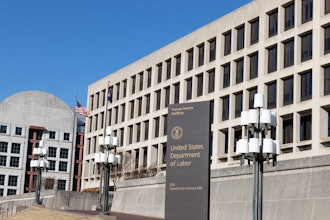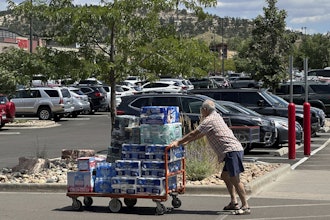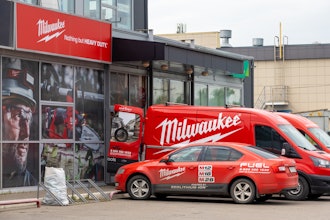REPO-01
Courtney Reagan, Kate Rogers>
Entertainment; Labor; Technology>
ANNOUNCER: This is NIGHTLY BUSINESS REPORT with Tyler Mathisen and Sue Herera.
SUE HERERA, NIGHTLY BUSINESS REPORT ANCHOR: Apple (NASDAQ:AAPL) sags. The stock that`s a big piece of many portfolios sees its lowest close since 2014. So what should you do when your blue chip turns a little gray?
TYLER MATHISEN, NIGHTLY BUSINESS REPORT ANCHOR: Powerful ideas. The ambitious energy goals of some of the nation`s biggest cities.
HERERA: Brave new world of recruiting. Why that mobile video game could be just the thing that helps you land your next job.
All of that and more tonight on NIGHTLY BUSINESS REPORT for Thursday, May 12th.
MATHISEN: Good evening, everyone.
A virtual tie at the top. The top of the list of the most valuable companies in the world. Apple (NASDAQ:AAPL) no longer comfortably number one, it`s neck and neck with Google`s parent Alphabet, the two jockeying back and forth all day long for that lead position. After all was said and done, here are the numbers and, man, are they close?
Apple (NASDAQ:AAPL) did close with a slight edge in market value over Alphabet. This is the first time, by the way, in two years that Apple`s market cap has fallen below $500 billion.
Easily today, Apple (NASDAQ:AAPL), the worst-performing stock in the Dow today, off 2 1/3 percent at $90.32. As people worried about slow demand as it weighed on those shares in front of the anticipated new iPhone launch that may come later this year, maybe not until next.
And shares of Apple (NASDAQ:AAPL) have been on a steady decline since its record high in February of 2015. The stock is down more than 30 percent, by far the worst stock on the blue chip average during that time frame.
HERERA: So, what do you do when one of your blue chip holdings starts to sag a little bit?
John Petrides joins us. He`s portfolio manager with Point View Wealth Management.
Good to see you again, John. Welcome back.
JOHN PETRIDES, POINT VIEW WEALTH MANAGEMENT: Thanks for having me on.
HERERA: You know, Apple (NASDAQ:AAPL) has been such a consistent performer for so many years. It`s been a leader in technology. Perhaps it was just a matter of time before it sees a setback like this.
But if you -- if you do own a large portion of Apple (NASDAQ:AAPL), what do you to when you start to see this kind of a turn?
PETRIDES: Well, I think you take a step back and look at your overall portfolio. If you own one position that`s dominating your overall portfolio and that`s driving down your returns you`re breaking rule 101 in management portfolio, don`t have all your eggs in one basket, right? You have to diversify among stocks and bonds.
MATHISEN: How much too is much in one stock?
PETRIDES: Yes, that`s a good question.
So, we typically manage for our clients at about 2 percent, 2.5 percent in one position and we try to diversify across different sectors in different industries within client portfolios.
HERERA: What about putting a hedge on? You know, maybe not in the options market, certainly. But how would you do it by perhaps adding other stocks to the portfolio that might offset a decline? Not necessarily just in Apple (NASDAQ:AAPL) but maybe another stock that has a larger position.
PETRIDES: It`s a great question. If we use Apple (NASDAQ:AAPL) as an example, right? There`s a technology stock, big cap, big balance sheet, a lot of cash. Maybe offset it with something like a Hershey`s, right? Consumer Staple, completely unrelated to the movement of Apple (NASDAQ:AAPL) and Apple`s own trends.
MATHISEN: You know, the old cliche is let your winners run and cut your losses. But if you let your winners run and you can get above that 2 percent, 2.5 percent through a threshold that you talk about, how do you know when to sell on either side of the winners/losers?
PETRIDES: Well, it always comes back to when you`re looking at your sell discipline, you have to answer three questions. One, what`s your price target? Is the stock overvalued or fairly valued?
The second question investors need to ask themselves is what is the original investment thesis you bought the stock for and is that now broken, right? So, did you buy Apple (NASDAQ:AAPL) today because you thought they were going to have iPhone 7, 8, 9, 10, and constantly reinvent themselves?
And the final question is, again, you don`t want -- going back to diversification 101, you don`t want one stock in the portfolio thriving your overall returns. So, concentration risk is something investors need to be mindful of.
HERERA: All right. John, good to see you again
PETRIDES: Thanks for having me on.
MATHISEN: Very helpful, John. Thank you.
HERERA: He`s with Point View Wealth Management.
MATHISEN: And on Wall Street, Apple (NASDAQ:AAPL) shares and technology weighed on the broader market as did ongoing concerns about consumer spending and retail weakness. When the tape was done for the day, the Dow Jones Industrial Average rose just nine points to 17,720. NASDAQ lost 23. The S&P was basically flat.
HERERA: To deal news now, Germany`s Bayer is reportedly exploring a potential bid for Monsanto (NYSE:MON). As first reported by Bloomberg, that deal would create the world`s largest supplier of farm chemicals and seeds. A separate report says BASF is also considering a takeover of Monsanto (NYSE:MON). Any get-together would be the most recent in a wave of acquisitions in the industry.
Earlier this year, a Chinese government-owned company acquired Syngenta for $43 billion. And in December, Dow Chemical (NYSE:DOW) and Du Pont announced a planned $68 billion merger. Today`s report sent shares of Monsanto (NYSE:MON) higher by better than 8 percent.
MATHISEN: Nissan will invest more than $2 billion for a one-third stake in Mitsubishi Motors. That controlling stake will make Nissan the largest share holder in the company. Nissan CEO Carlos Ghosn calls the investment a win-win. The combined production value will total about 9 million vehicles a year. Mitsubishi is currently in the midst of a gas mileage cheating scandal.
HERERA: And now to economic news, weekly jobless claims spiked in the most recent week. The number of Americans filing for unemployment benefits increased by 20,000 to a seasonally adjusted 294,000. That`s the highest level in 14 months. But some economists blame the Verizon (NYSE:VZ) strike since New York state provides unemployment benefits for striking workers.
MATHISEN: Three voting members of Federal Reserve expressed their views today. Kansas City Fed president Esther George said interest rates are too low. She observed the country is at or near full employment, in operation is close to the Fed`s target, and she believes the economy can support a normalization of rates.
In a presentation to business leader in New Hampshire the Boston Fed President Eric Rosengren said rate hikes should resume. Quote, "My own view is that we`re going to do things gradually, but that it would be appropriate to probably tighten a little more quickly than the financial markets are expecting."
And the Cleveland Fed President Loretta Mester today said, any uncertainty around the economy should not paralyze the central bank from acting.
HERERA: The Environmental Protection Agency issued new rules to require the oil and gas industry to cut methane emissions. Methane is the main component of natural gas and had previously been unregulated. Oil and gas companies will have to plug and capture leaks of methane from new and modified wells and storage tanks. It`s the latest piece of a broader push by the White House to cut greenhouse emissions. Oil prices settled at $46.70 a barrel.
MATHISEN: Even with oil prices at historically low levels, many cities are setting ambitious goals to use alternative energy sources. Investments are being made in long-term projects. As Jackie DeAngelis reports from San Francisco, making the transition is not an easy feat.
(BEGIN VIDEOTAPE)
JACKIE DEANGELIS, NIGHTLY BUSINESS REPORT CORRESPONDENT: Sunset Reservoir solar array is part of the city of San Francisco`s push to be 100 percent renewable and 100 percent greenhouse gas free by 2030.
This solar array was built in 2010 and its size, slightly smaller than a dozen football fields, and 24,000 panels, along with its placement in the center of a major city, make it an astonishing sight.
What does it mean to be 100 percent renewable? And how will this city do it? It refers to electric power generation and a combination of alternatives will fuel it -- hydropower, geothermal, as well as wind and solar. The latter are the higher-growth areas.
MAYOR ED LEE (D), SAN FRANCISCO: It`s good for our environment to get off of diesel fuel or greenhouse gas emission types of energy sources, fossil fuel energy sources, unto clean energy, is and should be what cities should all be about. We have a very serious climate action plan that is simply reflecting in three numbers. That`s zero, that`s 50, and that`s 100.
Zero waste, 50 percent of trips done on a stainable transit, and 100 percent renewable energy sources for all our power needs.
DEANGELIS: By the time the clean power San Francisco program is complete, it will not just make the city cleaner, it will also have generated a little less than 10,000 jobs. It also won`t cost as much as you might expect.
LEE: So, we`ll bring every one of the dollars that we`re spending on the up front into a cost-neutral basis and have that whole system paid for by itself.
DEANGELIS: And San Francisco isn`t the only city to do this but it may be the largest.
East Hampton, New York, is trying to convert to 100 percent renewable electrical energy by 2020. It`s a response to Hurricane Sandy which caused massive power outages. Aspen, Colorado, Burlington, Vermont, and Greensburg, Kansas, they`ve done already, too.
With oil prices in the $40s alternatives have fallen out of favor because traditional energy costs have come down. But that doesn`t mean the alternatives will be left for dead. Ongoing investment and changes in industry dynamics could set these companies up for a comeback.
JULIEN DUMOULIN-SMITH, UBS: You`re going to continue to see solar deployments happen irrespective of where the oil price goes. That may drive the global market. But at least here back in the States, you`re going to continue too see jurisdictions go for it.
DEANGELIS: San Francisco has faced its fair share of challenges as it executes this initiative. The largest perhaps getting all members of the community involved in a project. It isn`t just about the municipality and corporations. It`s about residents of all income levels as well. Because reducing the city`s carbon footprint is everyone`s responsibility.
For NIGHTLY BUSINESS REPORT, I`m Jackie DeAngelis in San Francisco.
(END VIDEOTAPE)
HERERA: And still ahead, power players Donald Trump, Paul Ryan. What happened at today`s meeting in the nation`s capital?
(MUSIC)
MATHISEN: The high-stakes meeting today in the face`s capital, the presumptive Republican presidential nominee Donald Trump huddled with GOP leadership, including House Speaker Paul Ryan, in an attempt to unify the fractured GOP.
John Harwood is following the story for us tonight.
An eventful day, right, John?
JOHN HARWOOD, NIGHTLY BUSINESS REPORT CORRESPONDENT: It was eventful, Tyler. Donald Trump has been the greatest show in politics all year and the same was true when he came to Washington to try to make peace with House Speaker Paul Ryan.
(BEGIN VIDEOTAPE)
PROTESTERS: People united will never be divided!
HARWOOD: One way to tell Donald Trump was in the building was the immigration protesters. The other was all the TV cameras, both outside the Republican National Committee for the presumptive nominee`s attempt to unite his party.
The meeting reflected the tricky challenge facing House Speaker Paul Ryan, a party leader but also a committed free market conservative and proponent of outreach, troubled by Trump`s policies and his tone.
Despite their differences, the speaker described the meeting as positive.
REP. PAUL RYAN (R-WI), SPEAKER OF THE HOUSE: I was very encouraged with what I heard from Donald Trump today. I do believe that we are now planting the seeds to get ourselves unified, to bridge the gaps in differences. And so, from here we`re going to go deeper into the policy areas to see where that common ground is and how we can make sure that we are operating off the same core principles.
HARWOOD: Trump`s message was the same. On his way back to New York, the billionaire businessman tweeted that the meeting was great, things working out well. But it still wasn`t an endorsement.
Rejecting Trump could spark a backlash from primary voters and hurt the entire ticket. But embracing Trump could make it difficult for Republican House and Senate candidates this fall to attract voters Trump has alienated like Hispanics and women.
(END VIDEOTAPE)
HARWOOD: The party needs those same voters to grow in the future like 2020, when a lot of people expect Paul Ryan himself may be a candidate for president, Tyler.
HERERA: John, a couple of questions for you before we let you go. Mitch McConnell has taken somewhat of a different approach from Speaker Ryan. Why is that?
HARWOOD: They have different approaches to their jobs, Sue. Mitch McConnell is a political animal. He`s very tactical, and is concerned about the smart political play. And that`s probably going ahead and quickly getting behind Donald Trump.
Paul Ryan is a conviction politician. He believes very deeply in limited government, lower taxes, curbing entitlement programs. Donald Trump has been in a different place on some of those issues, as well as trade and immigration, and he`s just going to approach it somewhat differently and more slowly.
MATHISEN: All right. How have rank-and-file Republicans been reacting to all of this?
HARWOOD: Well, there`s been progress from the Republican point of view. Donald Trump in some of the more recent polls has done better than he did in our April "Wall Street Journal"/NBC poll when he was only getting 72 percent of the Republican vote. You need around much higher, around 90 percent or more to have a united party and have a chance to win in November. Trump is getting closer to that number. We`ll see if he can get there.
HERERA: Wow.
MATHISEN: All right. John, thank you very much. John Harwood reporting in Washington.
HERERA: To retail. Nordstrom (NYSE:JWN), it`s the latest retailer to report weak quarterly results. It also warned about slowing sales.
The high-end retailer earned 26 cents a share, far below consensus estimates of 46. Revenue was slightly higher from last year. They also missed forecasts coming in at more than $3 billion. Shareholders didn`t like what they saw. Shares tanked initially in after-hours trading.
Courtney Reagan has more on Nordstrom`s soft results.
(BEGIN VIDEOTAPE)
COURTNEY REAGAN, NIGHTLY BUSINESS REPORT CORRESPONDENT: Nordstrom (NYSE:JWN) reporting results after the bell only added to the retail wreck we`ve seen recently. Shares tumbling after profit fell far short of expectations. While revenues were only slightly short, comparable sales fell nearly 2 percent. But what`s very telling is the difference between the performance at Nordstrom`s regular stores and website and its Nordstrom (NYSE:JWN) Rack outlet stores and website, nearly exactly opposite, with comparable sales down 4 percent at Nordstrom (NYSE:JWN) but up more than 4.5 percent at its outlet stores.
Now, beauty was the strongest department during the quarter for Nordstrom (NYSE:JWN), and beauty has been a strong point throughout retail recently. Many point to Americans` need to be photo ready at all times. Not that everyone carries phones with cameras. And social media posts document our daily lives.
Ultimately, Nordstrom (NYSE:JWN) did slash its full-year earnings and sales guidance going forward. For NIGHTLY BUSINESS REPORT, I`m Courtney Reagan.
(END VIDEOTAPE)
MATHISEN: Profit and revenue fall at Ralph Lauren and that is where we begin tonight`s "Market Focus."
The fashion retailer suffered from weak U.S. sales and costs associated with store closures. But it did manage to post results that topped street expectations. However, same-store sales declined by 6 percent, worse than estimates. The company added an additional $200 million to its stock share buy-back program. Shares rose over 2.5 percent, $86.88 was the close.
Ralph, Kohl`s saw earnings and sales fall too. The company reported an 87 percent profit drop in what the company`s CEO called a challenging quarter. Same-store sales dipped. Analysts expected a slight gain. Shares of Kohl`s (NYSE:KSS) down a big 9 percent at $35.15.
Meantime, Walmart will test a two-day shipping subscription service in an attempt to combat competition from, guess who, Amazon (NASDAQ:AMZN). The shorter delivery window will benefit Walmart members who currently subscribe to the retailer`s three-day shipping service called shipping pass. Shares of Walmart rose a fraction to $66.85.
HERERA: Shares of Jack in the Box surged after the restaurant chain reported earnings after the bell yesterday that impressed investors. Profit and revenue for the quarter rose thanks in part to better margins and cost controls. Shares popped 15 percent to $75.02.
Analysts at JPMorgan (NYSE:JPM) see downside risks ahead for General Electric (NYSE:GE). The bank resumed its coverage with an underweight rating and forecast the stock price to fall by more than 10 percent to $27 a share. A stubbornly high earnings expectation and weak underling earnings quality were among those concerns voiced by the firm. Shares of GE down just a tick nonetheless at $30.09.
Strong sales of the chicken shack burger helped drive results higher at Shake Shack. The burger chain posted a 43 percent increase in revenue and also saw a profit gain. The results topped estimates and prompted the company to raise its sales guidance for the year. Shares rose initially in after hours but ended the regular day down a fraction at 34.26.
MATHISEN: A new Gallup report says working millennials want more than just game rooms and rock climbing walls from their employers. In fact, those are pretty low on the list. Instead, the study found that this generation, the millennials, is looking more for purpose and development in the workplace.
Jeanne Meister is founding partner of Future Workplace joins us to talk about millennials and how they`re changing the workforce.
It`s a Freudian question. What do millennials want, Jeanne?
JEANNE MEISTER, FUTURE WORKPLACE FOUNDING PARTNER: Well, Tyler and Sue, actually, millennials want what we all want in the workplace, right? They do want purpose and meaning. They want to work from anywhere. They want workplace flexibility. And they want choice.
And what`s really reassuring that the Gallup poll didn`t address was how large companies like IBM and SunTrust are forming millennial affinity groups to really have millennials that work for those companies be advisers to the, on how to design products and services to meet the needs of their customers.
HERERA: And are they getting what they want? Because they`re the largest group now. They outnumber the baby boomers. And I may go to my boss and say, I want flexibility, I want work at home, I want whatever.
I`m probably, I`m guessing, less apt to get it than the millennial who will be spending more time working for that company?
MEISTER: Yes. And millennials are forcing companies to adapt to a new workplace that is definitely more open and transparent and a work from anywhere place. So, they`re really forcing changes in the workplace because they`re the dominant generation today as of 2015.
MATHISEN: Is money or promotions as important to millennials as they were to other generations?
MEISTER: Well, right now, when you look at the research, you find that millennials are more purpose-driven. It could be their age, right? I mean, they don`t necessarily have a family where money is a big issue.
What I find interesting is that one of our clients, SunTrust, found that 70 percent of the millennials they surveyed have a moderate to high degree of stress around financial literacy. So this particular bank has created a financial curriculum, because they believe that by offering everybody, especially millennials, programs on how to build financial literacy, they`ll be able to be more productive in the workplace.
MATHISEN: Just tell them to watch NBR.
MEISTER: Right, exactly.
MATHISEN: All right. Jeanne, we`ve got to leave it there. Jeanne Meister with Future Workplace.
MEISTER: Thank you.
HERERA: And as millennials do change the workforce, they`re also changing the recruitment process. This is the time of year when college graduates from across the country prep for those job interviews. But as the hiring process goes interactive, that obsession with mobile games like Candy Crush may actually come in handy.
Kayla Tausche explains.
(BEGIN VIDEOTAPE)
KAYLA TAUSCHE, NIGHTLY BUSINESS REPORT CORRESPONDENT: Forget the resume papers and the brain teasers, your first round job interviews these days may be a mobile game like Knack.
UNIDENTIFIED MALE: How many of you play any games?
TAUSCHE: A skill most millennials have. Colleges are holding mass competitions and companies use a scoreboard as their starting point. What they want is a deeper, more objective look at a person`s social skills or analytics or problem-solving.
GUY HALFTECK, KNACK FOUNDER AND CEO: Every game has its own folk point but we keep it short to about 10 minutes.
TAUSCHE: Former Deutsche Bank trader Sean McCormack thought Wall Street could use its own concept, enter, Stockfuse.
SEAN MCCORMACK, STOCKFUSE FOUNDER: The reason we chose a stock trading game for these institutions, and the reason they`re excited by it is all about lowering the barrier to entry. Right now financial services is kinds of intimidating to a lot of people who might be very good at it. And by making it as simple as buying and selling and climbing a leaderboard, these are things people understand.
TAUSCHE: It`s not a cakewalk.
By these shares --
There are rules to follow and risks to manage. Barclay`s, a backer of Stockfuse, wants to make the game part of its hiring process worldwide.
JANE CLARK, BARCLAY`S GRADUATE RECRUITMENT: There are 20 people this year who played the Stockfuse game who actually received offers from Barclay`s.
TAUSCHE: And they weren`t the ones who made the most money.
CLARK: It`s around the risk management, it`s around the critical thinking, it`s around looking at whether candidates have tried investment theories, whether they`ve learnt from those.
TAUSCHE: So companies get valuable data and hopefully a more level playing field for applicants.
MCCORMACK: It`s not about what you claim you can do on a piece of paper. It`s really about showing that you have these actual skills.
TAUSCHE: The C-suite included.
HALFTECK: Corporate offices and CEOs of companies playing Meta Maze for example and getting totally hooked and almost missing the flight.
(END VIDEOTAPE)
TAUSCHE: While most companies put their own unique spin on each of these games, the good news is you can practice both Stockfuse and Knack, available as apps to download. Almost everyone we talked to said it`s easy to lose track of time.
HERERA: I don`t know whether to download those or not. How many colleges or companies are actually using these?
TAUSCHE: So, it`s growing, whatever the number is. Knack actually has 200 companies including all the big blue chips -- GE, IBM, Anheuser-Busch -- that are using their game for the recruitment process. Stockfuse is focused a little bit more on the college recruitment process. They`ve partnered with 1,000 colleges. They hold these wide-ranging contests, everyone trades for a week and the finance companies look at the leaderboard to see who they want to interview.
MATHISEN: Can you beat the game, cheat the game?
TAUSCHE: I wish I could say you could. Unfortunately, they say you can`t. Although with stock season, particularly, the high score is 100. So, I have to imagine it could get pretty close.
HERERA: It makes sense. If you`re hiring somebody in financial services, you know, you want to see how they can actually perform and execute.
TAUSCHE: Right.
HERERA: Rather than hiring them and hope they perform and execute.
TAUSCHE: The most interesting thing about the Stockfuse game and the approach they`re taking is the one thing the recruiter said they pay closest attention to is whether you`re following the rules. Don`t trade in small caps that you`re not allowed to. Don`t trade more than you`re allowed to in a certain day or a certain period.
HERERA: Compliance.
TAUSCHE: Compliance, exactly.
HERERA: It`s compliance on a whole new level.
That`s great. Kayla, thanks. Good to see you.
MATHISEN: Thank you, Kayla.
Coming up, the 14-year-old who says $30 million just isn`t enough.
(MUSIC)
HERERA: Finally, tonight, a 14-year-old entrepreneur from Alabama. He had an idea for a class project and turned it into a business he says is worth millions, tens of millions of dollars, in fact.
Kate Rogers (NYSE:ROG) introduces us to this teen inventor.
(BEGIN VIDEOTAPE)
KATE ROGERS, NIGHTLY BUSINESS REPORT CORRESPONDENT: Taylor Rosenthal is a long way from his ninth grade classmates in Opelika, Alabama.
TAYLOR ROSENTHAL, RECMED FOUNDER: I think two weeks from now is finals.
ROGERS: Are they jealous you`re in New York?
ROSENTHAL: Uh-huh.
ROGERS: They think it`s pretty cool?
ROSENTHAL: They did.
ROGERS: But his big idea has brought him to the Big Apple (NASDAQ:AAPL). The 14-year-old is the founder of RecMed, a vending machine that dispenses first aid equipment. He`s already raised $100,000 from local investors.
ROSENTHAL: Imagine you`re at an amusement park and your child falls and scratches your knee. Well, instead of having to wait in a line for an hour, wasting possible fun time, you walk to our machine and can get quick and easy access.
ROGERS: But Rosenthal made headlines for turning down a $30 million buyout offer.
ROSENTHAL: I felt like I wanted to grow and develop the company a little bit more.
ROGERS: He says his magic number is a bit higher.
ROSENTHAL: Fifty million.
ROGERS: Fifty million?
ROSENTHAL: Yes.
ROGERS: The entrepreneur he most admires, Mark Cuban. And just like Cuban, Rosenthal has a flair for the flashy. Once he cashes out, he says he`ll put aside money to attend college at Notre Dame and to buy a Bentley.
What would you actually do with a Bentley? Because you`re 14, you can`t drive yet.



